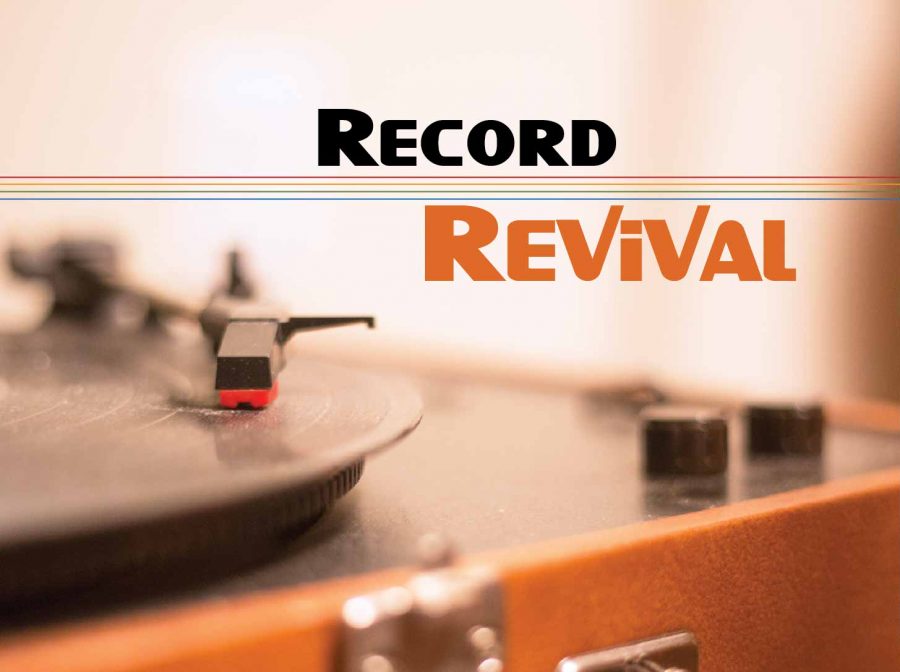Once upon a time, music meant something completely different than the sounds coursing through iPhone-clad students’ earbuds or car stereos. It meant gathering around a turntable and playing a vinyl record. It meant treasuring delicate records and listening to them the whole way through. But for an increasing number of University of Alabama students, it still means that same thing today.
Oz Music, Tuscaloosa’s sole record store, recently condensed its CD collection to make room for an ever-growing collection of vinyl. Jason Patton, manager of Oz Music, said vinyl records accounted for 14 percent of the store’s total sales in 2013.
“CDs by far are still our majority of business, but 14 percent is pretty significant when three years ago it was 7 percent,” Patton said. “So it’s doubled in the last three or four years. It’s significant enough to us to where we’re paying more attention to it and devoting more store space to it.”
This dramatic vinyl resurgence extends far beyond Tuscaloosa. Vinyl sales nationwide have skyrocketed over the past seven years, jumping from just under 1 million units sold in 2007 to 6 million units sold in 2013. This past year alone, vinyl sales increased 32 percent, up from 4.5 million units sold in 2012, according to billboard.com and their music tracking service, Nielsen Soundscan.
Not coincidentally, the upward trend in vinyl sales began around the same time as the first annual Record Store Day in 2008. Record Store Day, observed at record stores worldwide, brings together artists, record store employees and vinyl enthusiasts to celebrate the culture of independent record stores. Patton said the 2013 Record Store Day was Oz Music’s biggest day in the store’s history.
“I think [vinyl sales] are gonna continue to rise,” Patton said. “I mean at this point it’s pretty clear that the vinyl resurgence is not a fad. It’s not going anywhere.”
When people talk about vinyl, they’re usually referring to the 33rpm LP, which replaced the 78rpm in 1948 as the standard format for most vinyl albums. The smaller 45rpm, used for releasing singles, was introduced the following year. Then came cassettes in the ’70s, CDs in the ’80s, MP3s in the ’90s and music streaming in these past few years.
Yet people never completely stopped listening to vinyl. Somehow through decades of technological advancement and music format changes, vinyl has always managed to hold onto a small group of loyal fans.
“The compact disc seemed like it was going to destroy vinyl, but then no one ever really developed the same love for compact discs that they had for vinyl,” said Eric Weisbard, assistant professor of American studies. “When technology changed and it was possible to get by without ever owning a CD, many people thought, ‘Great, we’re not gonna miss ’em.’ Whereas vinyl always had fans along the way. Even when compact discs seemed to obliterate them, there were people who said, ‘I like the way music sounds on vinyl more.’”
Despite its recent surge in popularity, vinyl still represents only a minuscule portion of total album sales nationwide. As of 2013, vinyl accounts for 2 percent of total album sales, paling in comparison to digital albums, which account for 40 percent, and CDs, which account for 57 percent.
However, while vinyl sales have been steadily rising, CD sales, digital music sales and total album sales all decreased in 2013. Digital track sales fell 6 percent, and digital album sales fell .1 percent from 2012, making last year the first year since iTunes emerged in 2001 that digital music sales have fallen from the previous year. Additionally, CD sales declined 15 percent, and total album sales across all formats declined 8 percent.
So why, despite a decline in total album sales, have vinyl sales continued to flourish? Who’s behind this sudden vinyl resurgence? The answer can be found all around The University of Alabama campus – young adults, and more specifically, college students.
The vast majority of Oz Music’s vinyl customers fall in the 15-30 year old demographic, with most of those individuals between the ages of 18 and 22, Patton said.
“I think this generation has discovered ‘real music’ because the majority of their lives, all they’ve known are digital files,” Patton said. “They’re getting a little older, they found their parents’ record collection, they’re hearing music for the first time essentially because that’s how it was meant to be listened to, and it sounds better. So I think the younger generation is starting to appreciate how the music was supposed to sound.”
There’s an ongoing debate in the music world about whether or not vinyl records actually sound better than CDs, but Patton said the process of compressing albums onto CDs and MP3s compromises the music’s quality.
“When you take a piece of music, you have to compress it to make a CD,” Patton said. “So essentially, you’re chopping off some of the top end of that music spectrum and some of the bottom end of that music spectrum. And if you’re creating an MP3, you have to compress it even more. You literally are taking away sound from a recording. You can hear stuff on a piece of vinyl that you literally cannot hear on an MP3 recording of the same piece of music.”
Weisbard, however, said he’s not sure if these differences in sound quality actually exist.
“If you took three friends and had them sit with their heads facing away from a stereo, and you had vinyl, CD and MP3 recordings playing at different times and asked them to guess which was which, I’m pretty convinced most of them would not [be able to],” Weisbard said.
Young people haven’t suddenly started buying vinyl because of the way it sounds, but instead, because of the lifestyle it represents, Weisbard said.
“When it was the era of Led Zeppelin and Bruce Springsteen, vinyl stood for a kind of big rock counterculture,” Weisbard said. “Now, vinyl stands for a growing hipster subculture.”
Weisbard said many people today buy vinyl to separate themselves from the majority and to become part of a more elite culture.
“To get vinyl now is to, on the one hand, to have a longing for that time [when vinyl was popular],” Weisbard said. “But mostly, it’s to be pursuing a less mainstream identity. And it’s not just that vinyl’s getting more popular, it’s that the desire to be less mainstream steadily increases.”
Read Mills, a freshman majoring in philosophy and political science, delved into the world of vinyl about three months ago, and his collection features everything from classics, like the Beatles, to indie rock, like Imagine Dragons.
“I don’t think that I’m ‘sticking it to the Man,’ rejecting pop culture or challenging the technological revolution by listening to vinyl,” Mills said. “Many people that I know who listen to records want to hear the music the way it was meant to be heard, not overly compressed as to fit in the palm of our hands.”
Patton said the appreciation of vinyl extends far beyond the stereotypical hipster crowd, reaching all different types of individuals.
“I can’t speak for other stores and for other regions of the country, but for us, [hipsters] aren’t the majority of vinyl buyers,” Patton said. “To me, they’re not listening to it because it’s the hipster thing to do, they’re into the music part of it. It’s all walks of life. I wouldn’t say that the vinyl resurgence is just because a bunch of hipsters are listening to vinyl.”
Vinyl lovers often comment that listening to an album on vinyl provides a completely different experience from listening to that same album in CD or MP3 format. While digital music formats make it possible to pause, rewind and fast forward music with the push of a button, turntables don’t have these functions built in. Although it’s possible to skip songs by picking up the needle and placing it in a different spot on the record, people tend to just place the needle at the beginning of the record and let it play all the way through.
Weisbard said people tend to consume vinyl in the same way they would watch a movie or read a novel – as one cohesive body of work that unfolds over a period of time.
“Vinyl is incredibly limited in many ways, but I think that’s become part of [its] charm,” Weisbard said. “Its limitations reinforce the sense that when you are putting on a vinyl album, that’s what you’re doing. That’s your main thing. It’s not something you’re doing as a mood amplifier as you drive a long distance or something to put over your ears as you work out at the gym.”
Mills said the more hands-on process of playing a vinyl record helps listeners truly immerse themselves in the listening experience.
“With a record, you have to find it, carefully pull it out of the sleeve, set it onto the platter and queue the needle,” Mills said. “You put more time into playing a record, so you have invested yourself to listen to the music. You shut up and truly listen. Also, you can’t skip songs, so you listen to the entire album, in order, the way the artist intended.”
CDs and MP3s have a sense of convenience that vinyl records lack. People can take their entire music collections everywhere they go, and they can have music on in the background of whatever they’re doing. This phenomenon, though, can make it easy for people to listen to music all day without ever really hearing it, Patton said.
“When you’re talking about having your entire music collection on your phone or on an iPod, it gives so much more portability to it, but also I think it takes away from it,” Patton said. “I think it kinda pushes music to the background, and I think this resurgence of vinyl has brought music back to the foreground of a person’s life.”
Vinyl brings people together in a way that digital music cannot, Patton said.
“I think you’ve got kids sitting around in an apartment and listening to a piece of vinyl together,” Patton said. “I don’t know of anybody saying ‘Hey you wanna come over and listen to a playlist on my iPod?’ but I do hear ‘Hey you wanna come listen to this on my turntable?’”
The best way to truly understand the appeal of vinyl is to listen to it yourself, Mills said.
“Vinyl is something that has to be experienced,” Mills said. “People scoffed at me for buying a record player, writing it off as ‘outdated.’ Now I just laugh when all my neighbors come over to my dorm room to sit quietly and listen to my records. You don’t have to be a musician or an audiophile to hear the difference, you just have to be willing to close your eyes and listen.”









